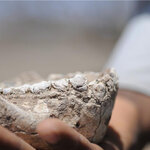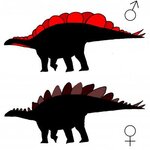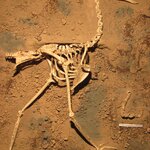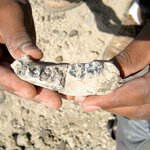Paleontology

In the blockbuster "Jurassic World", actor Chris Pratt joins forces with a pack of swift and lethal velociraptors. "Velociraptor belongs to a group of predatory dinosaurs called the deinonychosaurs, or simply the 'raptors'," says University of Alberta paleontologist Scott Persons. "Raptors are characterized by particularly nasty feet. Their big toes each bore an enlarged and wickedly hooked talon, which makes raptors well suited for Hollywood fight scenes."
Persons and University of Alberta alumnus Lida Xing are part of the research team that has just documented a rich fossil footprint site…

Jurassic World brings to life the fantasy of an amusement park where genetically engineered dinosaurs are the main attraction, as first imagined in the original book, then movie Jurassic Park back in 1993. This fourth movie in the franchise, in cinemas from today, is certainly action-packed, although there are a number of opportunities missed when it comes to how these beasts are represented.
Jurassic World’s dinosaurs are analogous to Frankenstein’s monster, and they unleash the catastrophic consequences we expect when hubristic scientists become obsessed with forbidden knowledge. In this…

I dissected a Tyrannosaurus rex in front of television cameras.
That may be the most surreal sentence I’ve ever written. So let me explain. I’m part of a team that built a life-sized model of Tyrannosaurus rex and then cut it up. The spectacle is a bloody, gory two-hour television special called T. rex Autopsy. The premise may seem absurd. But this is a whole new way of communicating science to the public, and it has been one of the highlights of my career.
I’m a paleontologist who has been studying dinosaurs for more than a decade. I’ve dug up T. rex fossils in the western United States,…

A new fossil hominid species has been discovered in the site of Woranso-Mille in the central region of Afar, in Ethiopia.
The new species is named Australopithecus deyiremeda and consists of the upper and lower jaws and a collection of teeth in the sites of Burtele and Wayteleyta, in Woranso-Mille, in the central region of Afar, about 50 kilometers north of Hadar and 520 kilometres northeast of the capital Addis Ababa. The fossil specimens are 3.3 – 3.5 million-years-old.
More than three-million years ago, the new species Australopithecus deyiremeda —name that comes from día-ihreme-dah…

Understanding extinct species diets requires greater understanding of the relationship between skull biomechanics and animals ancestry than previously thought, according to a new study.
The diet of long-extinct animals may be inferred by using modern animals with similar skull shapes and tooth patterns as models, but that would not mean that diet is the main factor influencing skull shape and biomechanics. Neanderthals did not have a chin, nor does any other animal, but that is not due to the modern human diet.
To understand whether these models might apply to living species, the…

Stegosaurus, a large, herbivorous dinosaur with two staggered rows of bony plates along its back and two pairs of spikes at the end of its tail, lived roughly 150 million years ago during the Late Jurassic in the western United States. Some individuals had wide plates, some had tall ones, with the wide plates being up to 45 percent larger overall than the tall plates.
According to a new study, the tall-plated Stegosaurus and the wide-plate Stegosaurus were not two distinct species, nor were they individuals of different age - they were actually males and females.
Professor Michael Benton,…

A new species of bird called Llallawavis scagliai (Scaglia's Magnificent Bird) is shedding light on the diversity of the group and how these giant extinct predators interacted with their environment.
The new species found in South America is the most complete terror bird ever discovered, with more than 90% of the skeleton exquisitely preserved and also reveals details of anatomy that rarely preserve in the fossil record, including the auditory region of the skull, voice box, complete trachea, bones for focusing the eye, and the complete palate, allowing an unprecedented understanding of the…

A new analysis of the long-necked dinosaur family tree says Apatosaurus excelsus is oh so wrong and Brontosaurus is oh so right.
Just like a hundred plus years ago.
In 1879, paleontologist Othniel Charles Marsh found a long-necked dinosaur fossil and concluded it was a new genus and species, which was named Brontosaurus excelsus. It had a really long neck like, you know...a Brontosaurus, if you are of a particular age and learned it as such. But it hasn't been that scientifically since 1903. Instead, it was determined that it was another species of late-Jurassic sauropod, similar Apatosaurus…

What do butterflies, spiders and lobsters share in common?
Yawunik kootenayi, a marine creature with two pairs of eyes and prominent grasping appendages that lived 250 million years before the first dinosaur.
The fossil recently identified is the first new species to be described from the Marble Canyon site, part of the Canadian Burgess Shale fossil deposit.
Yawunik had evolved long frontal appendages that resemble the antennae of modern beetles or shrimps, though these appendages were composed of three long claws, two of which bore opposing rows of teeth that helped the animal catch its…

The earliest known record of the genus Homo dates to between 2.8 and 2.75 million years ago, according to an international team.
Hominins are the group of primates that include Homo sapiens -- humans -- and their ancestors. The term is used for the branch of the human evolutionary line that exists after the split from chimpanzees. Directly dating fossils that old is impossible, so geologists use a variety of methods to date the layers of rock in which the fossils are found. The researchers dated the recently discovered Ledi-Geraru fossil mandible, a lower jaw with teeth recently found…